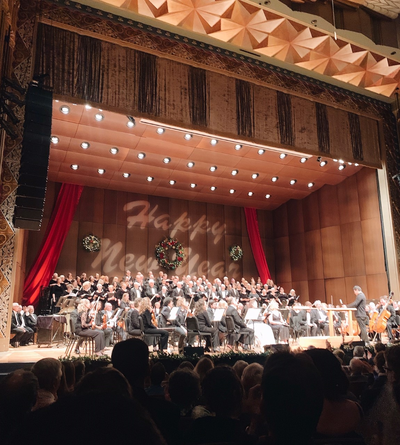Spokane Symphony offers brilliant Beethoven on NYE

Around 8 o’clock on Tuesday night, baritone Charles Robert Stephens rose from his chair on the stage of the Martin Woldson Theater at the Fox and began to sing “O Freunde, nicht diese Tone [O friends, not these sounds]!” to a rapt audience of New Year’s Eve revelers as other baritones were doing, or had done, at the same hour in their respective time zones all over the world.
Like theirs, Stephens’ brief solo took place in a performance of the Ninth Symphony of Beethoven, continuing a tradition begun 12 years ago in Spokane and extending back more than a century in Europe and Asia. Why? Why do we turn to this work above all others as a means of celebrating the passage from the struggles of the old year to the hopes of the new?
Many point to the symphony’s last movement, which contains a setting of a poem by Friedrich Schiller widely known to contain the phrase “Alle Menschen werden Brüder [All men shall be brothers].” It is a noble sentiment, and the tune to which Beethoven set it is certainly a rousing one, but does that explain the universal appeal of Beethoven’s strangest and most challenging symphony?
Not surprisingly, the reason lies rather in the experience of listening to it from first note to last, an experience that Beethoven planned and managed in a way that is singular in European symphonic literature.
Beethoven usually announces the key signatures of his symphonies quite forcefully, as he does by hurling two fortissimo E-flat major chords at the listener in the first measure of his Symphony No 3, the “Eroica.” In the Ninth, however, it at first seems as though the base note of the scale Beethoven has chosen is an “A” … but no, now it seems that it has changed to “D.”
But what mode are we listening to: Major or minor? For 17 measures, there is no way to tell, and no sooner does the composer seem to settle on D minor than D major takes its place … and so on, fluctuating between major and minor to the close of the first movement and beyond into the second, a jittery, joyless scherzo.
On Tuesday night, a packed house at the Fox was led on this journey by Morihiko Nakahara, resident conductor of the Spokane Symphony, joined by the Spokane Symphony Chorale, directed by Kristina Ploeger-Hekmatpanah, and four soloists. In addition to Stephens, we heard Amy Porter (soprano), Patti Mortier (mezzo-soprano) and Stephen Rumph (tenor).
Considering the celebratory nature of the evening, one might reasonably have expected to be treated to a decent, tidy run-through of a familiar symphony before being sent off to enjoy the remainder of the evening.
The performance Nakahara gave, however, will be burned into the memories of everyone who listened through its unrelenting energy, brilliance of execution and emotional authenticity, the very qualities that make Beethoven’s Ninth Symphony the immortal masterpiece it is.
Conducting the huge work without a score, Nakahara observed Beethoven’s rapid tempo markings, which sharpened contrasts and emphasized emotional turbulence.
Ignoring the tendency of many conductors to slow the third movement to a crawl, he maintained a flowing tempo in the proper relationship to the surrounding movements, and, in so doing, allowed the audience to perceive the restlessness and dissatisfaction that lies beneath its filigreed surface.
While Nakahara’s tempo choices clarified Beethoven’s intentions for the audience, they also increased the already great demands the piece makes on the orchestra. The Spokane Symphony responded not only with impeccable accuracy, but also with playing of great sensitivity.
The string basses, led by principal Patrick McNally, introduced Beethoven’s great melody with perfect unanimity of phrasing and a quality of tender hesitancy that must have been exactly what the composer had in mind. Nakahara’s infallible ear for balance allowed a wealth of woodwind detail that is often overwhelmed by strings and brass.
It’s a good thing, too, because the flute/piccolo trio of Bruce Bodden, Colleen McElroy and Jennifer Slaughter played with fabulous technique and character. The timpanist in this piece is elevated almost to the role of soloist, and the redoubtable Meagan Gillis seemed incapable of finding anything other than the precise center of the beat regardless of how breathless the tempo became.
One cannot overemphasize the contribution made to this performance by the Spokane Symphony Chorale, whose stature seems to grow with every performance. It contains many members who have sung with the chorale for decades, including Billie Severtson, who not only raised her voice, but also opened her pocketbook to help sponsor the concert.
The sound produced by the group was youthful, fresh and vibrant. They reproduced not only the pitches Beethoven intended, but also the spirit he wished to convey, to inspire to rise above adversity and defeat and celebrate the primacy of hope. The sound they created at the words “steht vor Gott [stands before God]” was so remarkable it ceased to be sound and became light.
It should be noted that the chorale included a ringer: baritone, and former principal conductor and music director of the Spokane Symphony, Eckart Preu, who 12 years ago initiated the tradition of performing Beethoven’s Ninth on New Year’s Eve, and who did much to build the orchestra into the magnificent ensemble it is now. Our debt to him is great.